Simple solutions for AVL integrators to help houses of worship improve their basic streaming setups and create more engaging online content.
One of the biggest effects that the novel coronavirus (COVID-19) pandemic has had on the house-of-worship (HoW) market has been the widespread growth of online streaming. Many HoWs that had never dabbled in on-demand video or livestreaming before had to add these offerings quickly in order to keep serving their congregations amid pandemic-related shutdown orders. And many of those HoWs that had already been involved in rebroadcasting their worship services online decided to increase their investment in audio, video and lighting (AVL) in order to improve the quality of their broadcasts and, thus, attract even more stay-at-home worshippers.
Growth Of Worship Streaming
Sound & Communications’ latest Worship Center AV Survey report offers some insight into just how quickly online video has become ubiquitous in the worship sector. One part of the survey offers a five-year trend on whether HoWs currently rebroadcast their services or archive them for on-demand viewing. In 2018, 65 percent of HoWs responded that they did not rebroadcast services or offer them for on-demand viewing; in 2019, that number fell to 52 percent; by 2020, it was 40 percent; finally, in 2021, that dropped all the way to 15 percent.
Although the explosion in online streaming for worship over the past year was a direct result of the pandemic, it is not expected to be a temporary change. Now that the end of the pandemic is hopefully in sight, and congregations are returning to in-person gatherings, there are few who think that houses of worship will scale back their current emphasis on streaming. Rather, it is expected that the widespread use of streaming for worship will be one of the permanent changes in society ushered in by the pandemic, and therefore HoWs will continue to make investments in AVL technology related to online streaming going forward.
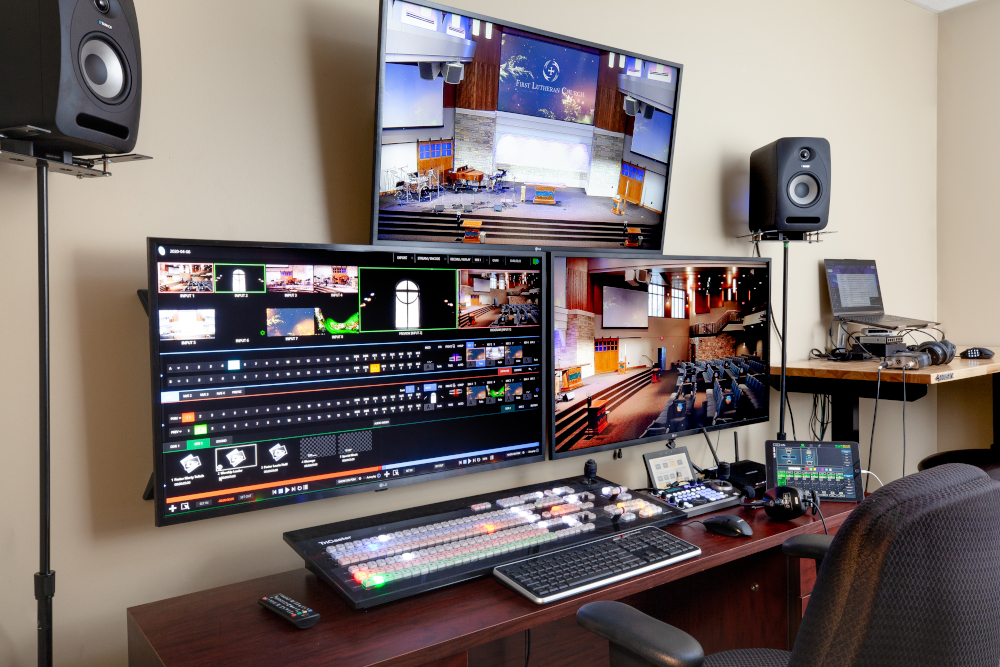
For AVL integrators that serve the worship market, the growth of video streaming offers opportunities to expand their client base and to increase their bottom line over the long term, if not the short term. But before integrators can help their HoW clients take the next step in improving their streaming setups, there are a few questions that should be answered. What does a basic video streaming setup for worship look like? What are some common areas in which HoWs need to step up their streaming game? What technology can help HoWs improve their online offerings? And how will the newfound popularity of online streaming for worship affect expectations for the in-person worship experience?
To answer these questions and more, we turned to Sound & Communications’ resident worship market expert and author of our monthly “House of Worship: Business” column, David Lee Jr., PhD, for his perspective.
Improving On Basic Streaming Setups
Because many HoWs are new to online streaming, having only adopted the practice in response to pandemic-related restrictions on public gatherings, many still have rudimentary online streaming setups that were cobbled together from whatever equipment was available on the market at the time. (And, because of the rush on video streaming equipment in the early days of the pandemic, these supplies were, of course, limited.) Integrators will find that these types of starter setups leave a lot of room for improvement.
“In your small churches, it’s as simple as setting up a smartphone and setting up a Facebook Live account. You see quite a bit of that, actually,” Lee described. “Your mid-sized church may already have a camera or two, but some still, believe it or not, have the smartphone. And they’re typically allowing the audio to come through the phone as well. So, you get this tinny, not really good-quality or high-definition sound, with the room echo.”
Consulting On Content
In addition to offering advice on how to upgrade from a tech standpoint, integrators should offer advice to their HoW clients about how they can improve their online content. “When a church calls me, I look at their stream, I look at what they’re doing, and I do an analysis to see what I can offer them, not just with tech, but content creation and things they can do to enhance their content,” Lee said. “I’m not just selling the technology. I’m going beyond the scope of integration and saying here are some tips that can make your broadcast or your livestream more effective. By adding that component, it’s building the relationship.”
There are some common, but easily fixable, mistakes that many HoWs make when they are new to creating video content. “One of the most common poor use cases you see is, they set up a wide shot maybe from the back of the room or up in the balcony. And there’s just so much information that is lost in that wideness, being so far away,” Lee said. “Ninety three percent of the information that we get from people is non-verbal—the body gestures, the eyes, the eyebrows—and that’s all lost. So, even though there is a sense of connectedness, viewers are not going to really engage.” He continued, “A majority of people are watching the stream on their smartphone, so a wide shot is totally lost because your screen size is so small. You need close-up shots in the stream in order to keep people engaged. Otherwise, you just feel like you’re sitting far away in a large auditorium.”

Lee also pointed out that some HoWs can get a little overambitious once they upgrade to more professional equipment, and that integrators should advise them to keep their production simple until their team gains more experience. “Once people get some equipment, I see them trying to do too much production,” he said. “Unless you’ve got high-level people who are skilled to do it, I recommend that you frame good shots and let the content be king.”
Video
For HoWs that are currently using a phone to capture their video content, “You want to try to move the church into at least a single-camera situation with some type of small video switcher,” Lee said. “For under two thousand dollars, depending on the camera purchase, a small church can have a much-better-quality product than just using a smartphone. Blackmagic, for example, has a popular switcher that’s available for around five hundred dollars. I like the AJA HELO as far as low end [streaming devices].”
However, Lee advised that most churches should be using two cameras at minimum in order to allow for switching between close-up and wider shots, which makes video content feel more dynamic. “Two is the minimum, for sure,” he said. “What that enables you to do is maintain what we call a head-to-toe shot, and then the second camera would be for close-ups. So, if you have a person at a podium, you have a head-to-toe and then a close-up. If that person moves, it gives you that head-to-toe shot to follow the movement, and then gives you the other camera to frame up the next shot.”
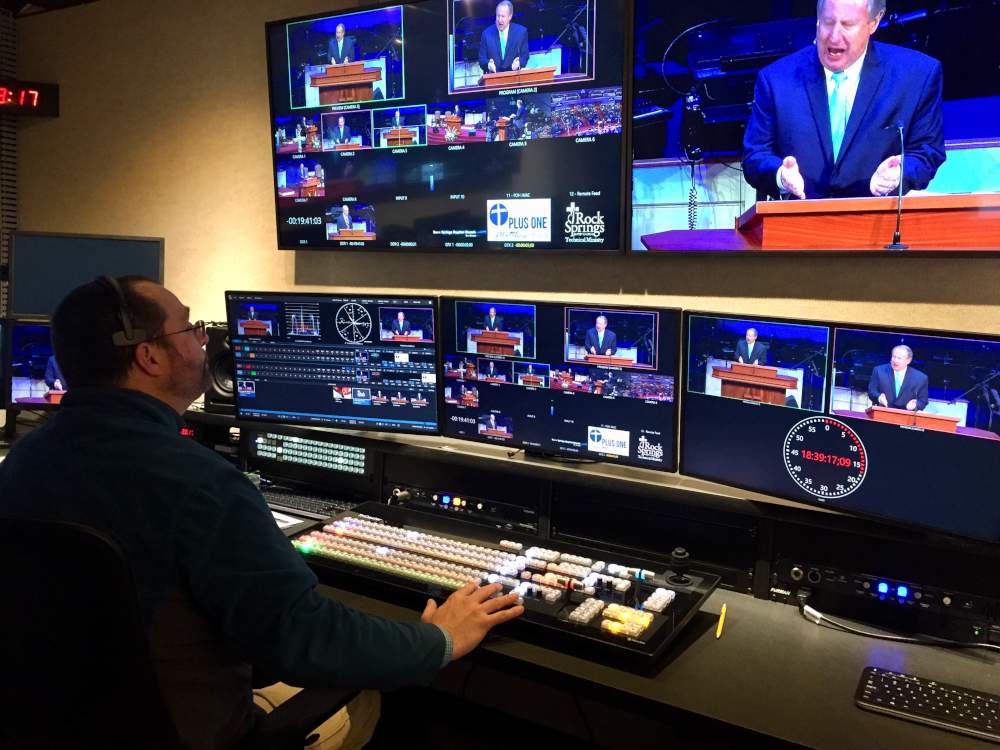
The best possible approach is to tailor the number of cameras and their locations to the needs of the particular HoW and how it conducts its services. “If you’re thinking more of in terms of traditional churches, or in the Catholic faith, for example, there are going to be fixed positions,” Lee said. “You could put cameras in these fixed positions, so that all they have to do is take to that camera when a person is at the pulpit, for example. And then you would have other cameras that would cover the other locations.” He continued, “In your contemporary churches, where there’s a lot of movement, we need at least two cameras that are focusing on the stage area. The close-up shot is picking up either the person speaking or the person singing, but the wide shot establishes, say, the whole band or the whole worship team. So, two would be the minimum. Of course, the more you add, the more flexibility and the more creativity that you have.”
Lee also mentioned that there are currently cameras on the market that can offer flexibility in terms of switching between shots without the need to add separate cameras for capturing each shot. “You can simulate multiple cameras, depending on your situation, with some of the new 4K PTZ cameras and their controllers,” he said. “We kind of favor the new Panasonic cameras with their PTZ controller. Being in 4K enables you to zoom in and get close-ups, but the quality still looks good. And, especially if you’ve got a person in a fixed position, one camera can be used to create three, four, six different angles, or even more.” Certain PTZ controllers also allow users to program presets for frequently used camera shots. “So, you can make one camera capture the head-to-toe shot, and by pushing a button, almost like you would on a video switcher, it’ll switch to the close-up,” Lee described. “Button one gives you the close-up, and button two gives you the head-to-toe, all within the same camera. It operates seamlessly.”
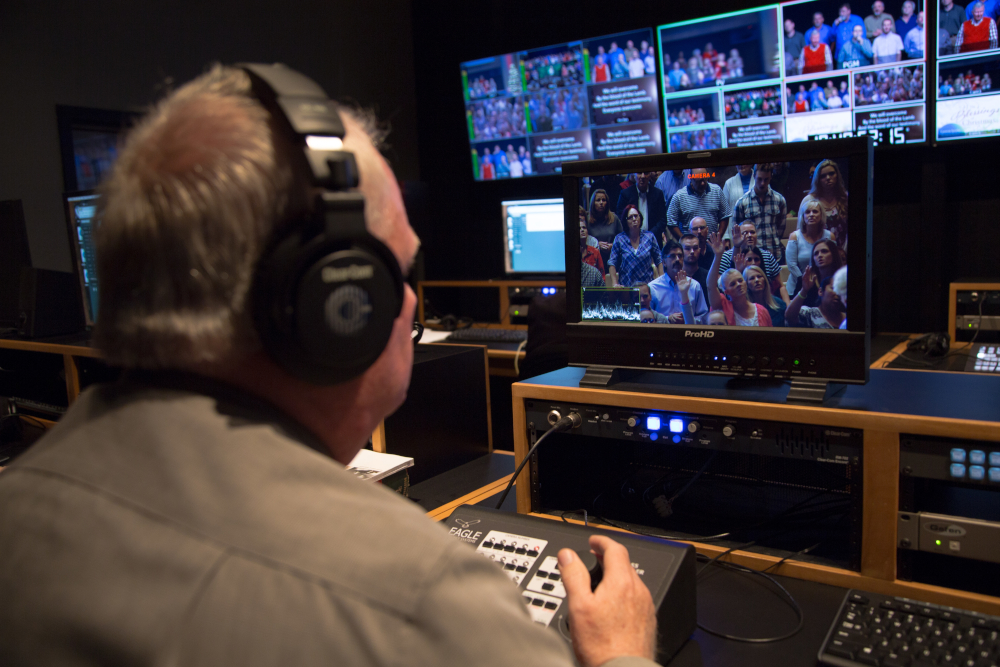
Another way for smaller HoWs to improve their video content is to include closed captions. “Closed captioning is huge, and that’s an area that I push a lot,” Lee said. “Thankfully, YouTube will do that for you automatically, and churches should take advantage of that. And there are all kinds of devices and smart systems.”
Audio
For many HoWs, audio capture for online video is treated as an afterthought. Typically, built-in camera mics are being used to capture the ambient sound from the room without any attempt to produce a dedicated mix for the online video. Therefore, an easy step to take in drastically improving the production quality of online video would be to provide the client with an audio console that will allow the creation of a dedicated mix for online content that is separate from the in-room audio mix.
“The very first step that I would encourage even the smallest churches to take is to purchase an audio console, an audio mixing board, that will enable them to provide a good mix for the people that are attending in person and that at least has an aux feed, or auxiliary mixing capability, that the operator can use to mix a feed for the live stream,” Lee said.
As churches shift to a hybrid model of worship—reopening for in-person services while still producing online streams for at-home worshippers—this will necessitate the simultaneous production of dedicated mixes for the in-person service and the online service. Lee recommends using digital consoles to streamline the production of these separate audio feeds.
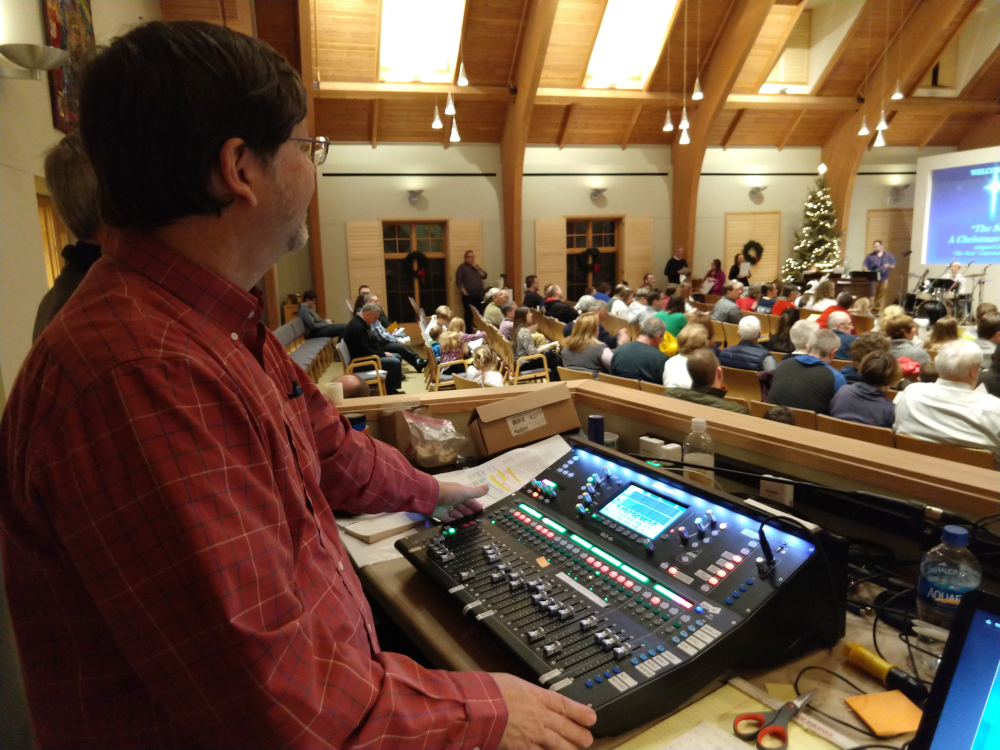
“The ideal way to do the hybrid service these days is to have a front-of-house mixer, console and operator, and then a separate broadcast mix, ideally in the same console,” Lee said. “In the digital world, that’s easiest to do, because if you have the same consoles, you can attach both consoles to the same digital snake or stage box, and that way you’re sharing all the same inputs. So, you’re able to create a customized mix for the live stream that is separate from what the mix is for the front of house. And that gives you the best opportunity to create an experience for the online audience that meets their needs, that fits the sound of their phones or their TVs at home.”
He continued, “The thing that churches and leaders need to understand is that you need to treat your online audience as though they’re in a completely different venue than your in-house, because it’s two different sound environments. In your living room, or in your car, or on your phone, it’s just a different experience than being inside the auditorium where you’re taking advantage—for better or worse—of reverberations and reflections. You have to recreate that in the broadcast mix to give you a sense of being there. It’s super important to do that.”
Lee added that another way to improve the streaming experience for at-home worshippers would be to mic the in-house audience and subtly include the audience tracks in the online mix. “They can enhance the feed for the online audience by adding some audience mics in addition to the regular mics, so that there is a sense of being there. They’re hearing the room a little bit, so they feel like they’re part of the experience overall,” he said. “The mistake that churches often make in that regard is that the online audience hears the stage, they hear the people singing, they hear the person speaking, but it feels dead because everything is clamped down so much that they don’t get a sense that there’s an audience there. So, you want to use some audience mics to bring that in just a little bit.”
Lighting
According to Lee, “Lighting has been the number-one area that most churches realize they have been neglecting. Lighting is almost always bad in smaller to medium-sized churches; it’s fine for the in-house experience, but not good enough for also adding the streaming component.” He continued, “Pre-COVID-19—when it wasn’t considered to be that important to have a streaming service—churches just kind of let things be as they were; small churches, in particular, might just have run with their overhead fluorescent lights. And then, when they look at it online, everything kind of looks green and shabby.”
The scramble to improve online video production in the wake of the pandemic has opened up a lot of opportunity for AV professionals with expertise in lighting. “Lighting has been the busiest area since the pandemic for our particular company,” Lee said. “And lighting was not our strong suit, but I brought in people [for whom it was]. Living here in Orlando, you’ve got a lot of Disney folk and Universal folk who have been without work, and so they’ve been really eager and grateful to have work again in lighting and those areas.”
One basic thing that most HoWs need some help with is properly lighting subjects for the camera. “Adding plain white base light, even if it’s old-fashioned PAR 64 cans or some of the newer LED fixtures and PAR cans, is absolutely imperative to have any type of stream,” Lee said.
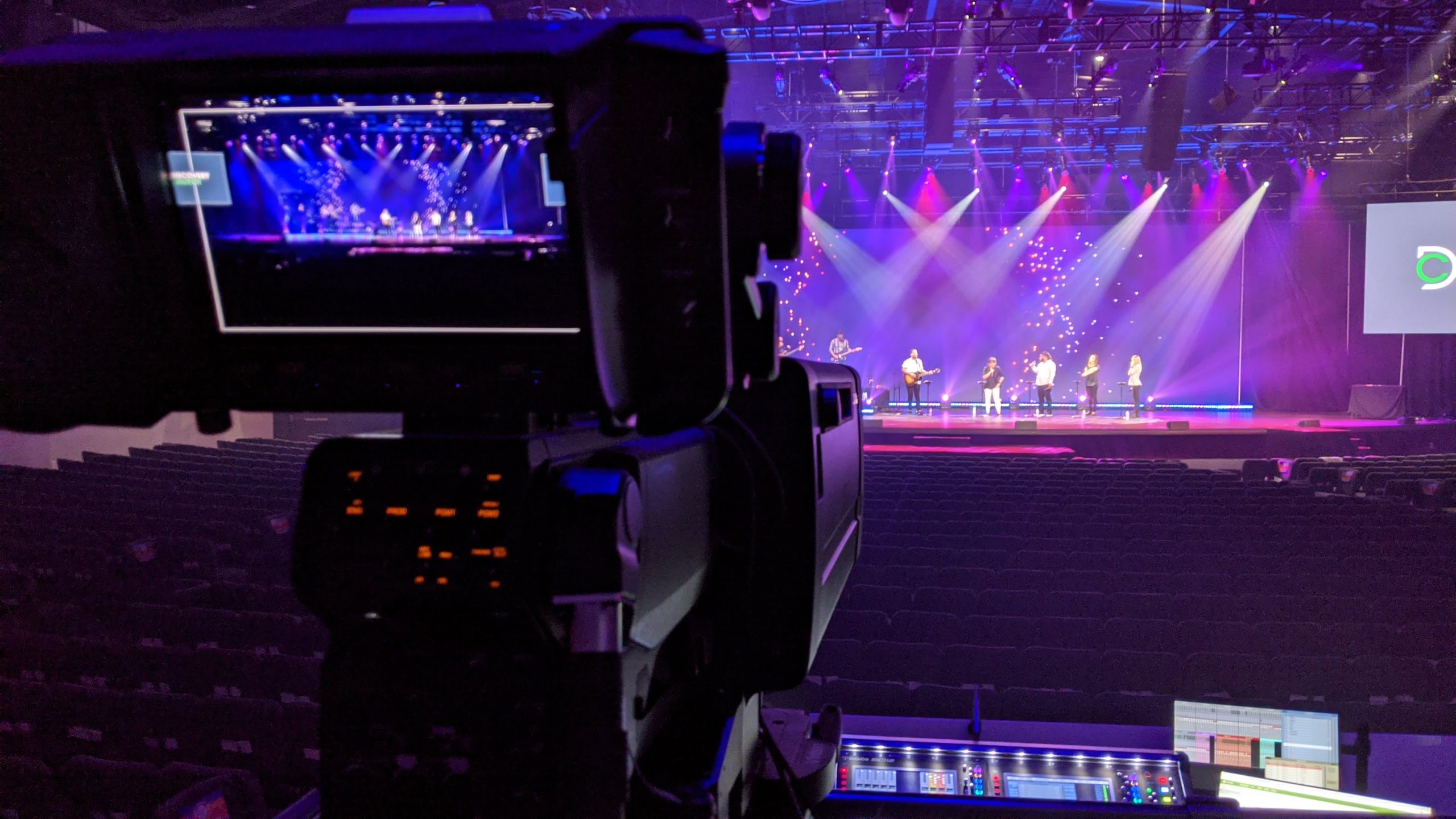
Some HoWs may also be interested in adding moving lights, colored lights and similar effects. “The purpose of moving lights is to create movement, create energy, create excitement, create mood. Although they are not as critical for streaming, they do enhance the look of the wide shot. On the close-up, you don’t always see them as much,” Lee said. “What some churches don’t quite understand, and so it’s something you have to consider philosophically—if you’re going to use moving lights and colored lights, you really need to use smoke, haze or fog, because otherwise you don’t get the full effect of seeing the beams. And some churches, philosophically, don’t want that.” He added, “Moving lights are used a lot these days as primary lights, meaning they’re used in the same capacity as white lights like a PAR can would be. But they have more flexibility to be able to move them as needed to reset a location versus once you put a fixed light up.”
Countering Complacency
Based on the data compiled for Sound & Communications’ latest Worship Center AV Survey report, it seems the majority of HoWs are working on improving their streaming capabilities. When asked about their plans for streaming going forward, 30 percent of HoWs responded that they had recently introduced streaming as a result of the COVID-19 pandemic, 18 percent said that they had already been streaming for a while but they’re looking to improve their offerings, and five percent said that they do not currently stream but they’re looking to add the capability.
However, it is worth noting that 35 percent of HoWs said they have been streaming services for a while and are satisfied with their capabilities, and 12 percent said they do not currently stream services and have no plans to do so. What advice does Lee offer to help convince HoWs like these that it’s in their best interest to continue to improve their production for online video, even if they feel their current streaming setups are enough to satisfy their needs?
“That’s probably one of the biggest challenges that we face,” Lee said. “But nobody has perfected online streaming. Nobody, even the best of the biggest, is creating an online experience so that it—as close as possible—approximates the live experience. So, that’s the angle that I approach. I would ask, ‘When you watch your stream, are you feeling confident that it’s recreating what’s happening inside your auditorium when you’re doing a service?’ And if not, that’s the motivation to keep moving forward.”
He continued, “For those churches that are satisfied, then that’s probably where they will stay, but the truth is, they’re going to get left behind. So, if they are content and complacent, I raise the point that you need to be looking down the road and constantly improving. Because the audience education is improving, and the audience demands are [increasing]. These are the same factors that drove the massive production gains through the late ’90s and 2000s up until now. People understand what production is more, they are becoming more sophisticated, and their knowledge and understanding of what looks good and what sounds good is growing.”
Because of heavy competition in online content creation, some HoWs might feel like they have no chance of competing with the established online streaming giants, and therefore, there is no need to invest in improving their own video production. “Your big groups—like Hillsong and Bethany in the Christian world—they’re constantly upping their production quality. And, so, there is a sense of having to strive to get to those levels,” Lee said. “I think it is important to do that and to try to be the best you can. But some churches will say, ‘We’re good enough already, because we cannot compete with Hillsong or Bethany.’ And there’s some truth to that. But at the same time, even though people may be watching those other high-end productions, [those churches] are not going to help anybody in your community with their basic human needs. That’s why it’s still important for you to be relevant with your congregation, with your community.”
Other Online Offerings
One way that HoWs can more directly connect to their communities is by creating more community-oriented online content. Because the pandemic has upended a lot of the old ways of doing things, people are more open than ever before to thinking outside the box. They are also more used to consuming a variety of digital content. Integrators should emphasize that there are other ways for HoWs to reach their congregations than by simply livestreaming or recording their services. These could include podcasts, musical performances, livestreamed prayer groups, youth-oriented content, weekly addresses from church leadership and more. If a HoW is interested in creating this type of content, an integrator can help them design spaces dedicated to recording video, a podcasting or recording studio, or even a small broadcast studio.
Building Your Client Base
Helping smaller HoW clients improve their streaming setups likely won’t result in big profits for an integrator in the short term; however, taking the initiative on these projects can position the integrator as a trusted partner that will be relied on to serve the HoW’s future AVL needs. Opportunities could materialize down the road for more expansive installations, and some HoWs might even be interested in entering maintenance or managed-service contracts as their AVL systems get more sophisticated.
“I don’t overlook those opportunities. What I find is that, once I make a friend, then I typically have a client for life,” Lee said. ”And, so, even though in the initial stages it might not be worthwhile financially, almost inevitably at some point, whether it’s three years, five years down the road, there is an upgrade that does lead to profit. When that opportunity arises, they’ve got a trusted friend. So, we always provide a service that they can rely on. It’s not about looking for a cash cow, but, [rather, about] taking an opportunity to serve people and help people. And I believe that’s a fundamental reason why, even through the pandemic, we have not let up one bit.”
Click here to read the full 24th Annual Worship Center AV Survey report.